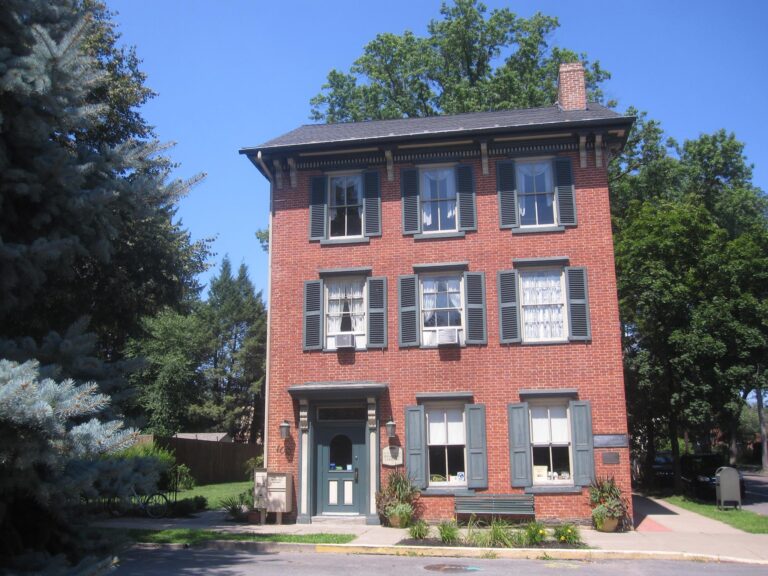History
History of the Priestley-Forsyth Memorial Library
 The original portion of what is now the Priestley-Forsyth Memorial Library was constructed between 1814 and 1828 as a two-story home. Historical evidence suggests the middle section of the building was the original construction. However, some believe that it was built last in order to connect two free-standing homes that would now be considered the front (facing King St.) and back of the library.
The original portion of what is now the Priestley-Forsyth Memorial Library was constructed between 1814 and 1828 as a two-story home. Historical evidence suggests the middle section of the building was the original construction. However, some believe that it was built last in order to connect two free-standing homes that would now be considered the front (facing King St.) and back of the library.
The building functioned as the Cross Keys Inn from 1829 until 1864. Theodore Burr ran the Inn, which later became known as the Central Hall Hotel. Because of its proximity to the “Danville Highway,” the railroad, and the river lines, the Inn served many more purposes than simply for boarding. Inns like the Cross Keys operated as taverns for gathering passengers, as collection sites for transported goods, and as meeting places for hungry, thirsty, and tired travelers, drivers, and even horses. Stagecoach drivers slept for a discounted rate in huddled semi-circles around the twelve fireplaces, while other travelers stayed in one of the Inn’s five large guest rooms. The local community probably used the Inn’s large front room as a bar and meeting room to share news and read announcements for public sales facilitated by traveling merchants.
Since illiteracy was common during this time, the Inn had no address or lettered sign to identify the building to passersby. Instead, the image of crossed keys stood out as a sort of logo on a large sign outside, making the Inn’s name very easy to remember. This make-shift marketing technique proved to be very successful; the Inn was renowned for its good food and fine lodgings, which attracted customers from great distances.
The building is typical of three-story Pennsylvania taverns of the Federal period, but showcases many eclectic architectural accents added through the years. The brickwork remains in its original Flemish bond pattern, while the first floor comprises more modern features from fireplace, mantle, and molding renovations in the mid-1800s. The difference in shutters is indicative of more interesting details—the ground floor has solid shutters, which match the panels on the roof overhang, while the second and third floors have louvered shutters. The corbel brackets are typical of the Gothic revival, as is the woodwork around the first and third floor windows.
In 1864, Joseph Priestley, M.D., a great-grandson of the Reverend Dr. Joseph Priestley, purchased the Inn and remodeled it into a residence for his wife, Hannah H. Taggert, and their four daughters: Hannah Priestley Catlin Milliken, Frances Priestley Forsyth, Sarah Ann “Annie” Priestley, and Jean Biddle Priestley. Dr. Priestley was born September 22, 1819 in Point Township, Northumberland County, where his family had been established since 1794 when his great-grandfather, Joseph Priestley, settled here from England. Dr. Priestley, the owner of the property, attended a local private school, read medicine in nearby Milton, and was graduated from the University of Pennsylvania in 1844. He practiced medicine in Northumberland for forty years and was considered to be one of the foremost physicians in the region. Dr. Priestley attached a medical office to the west side of the building and practiced there until his death in 1883. The medical office attachment was later moved and used as a school house on 2 Street.
Jean and Annie, to whom the house was willed, continued to live in the home while they served as active members of their community and taught music in the front parlor. When Jean and Annie passed away in 1919 and 1923, respectively, Frances Priestley Forsyth became the only surviving daughter. She and her sister-in-law, Mary Forsyth Herr, endowed a library in 1922 in memory of their families. Then, in 1926, they donated the Priestley home to become the Priestley-Forsyth Memorial Library.
Shortly after the endowment, reservations took place to prepare the structure. It was the founders’ intentions to make the Priestley-Forsyth Memorial Library one of the most beautiful libraries in the country. Miss Jessie Wilson was the first librarian. She oversaw the library’s growth to 5000 books in just two years. In 1930, the bookshelves that line the walls on the main floor were installed and the bronze lanterns manufactured by Tiffany Studios in New York were added to the front door. More recent renovations started in 1956, beginning with the first two floors. In 1963, what used to be an apartment became the current computer lab and staff area. In 1968 the front room was carpeted, and in 1980 the building’s exterior was sanded down and repainted.
In 1981 the building was listed on the National Register of Historic Places. The Priestley-Forsyth Memorial Library is located in the Northumberland Historic District and is registered in the National Register of Historic Places. Original application for National Register of Historic Place.
